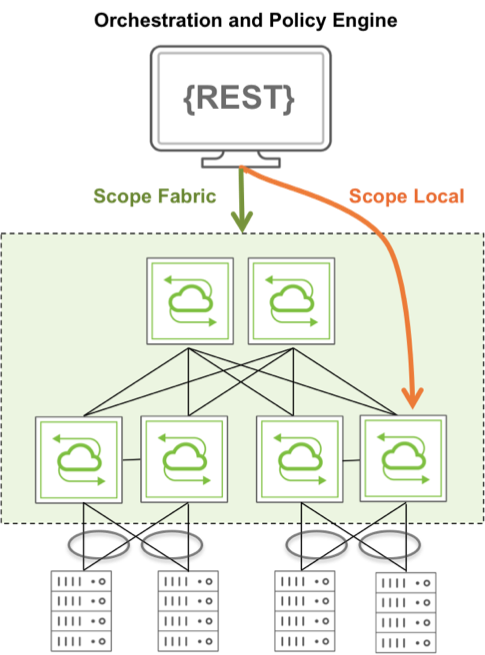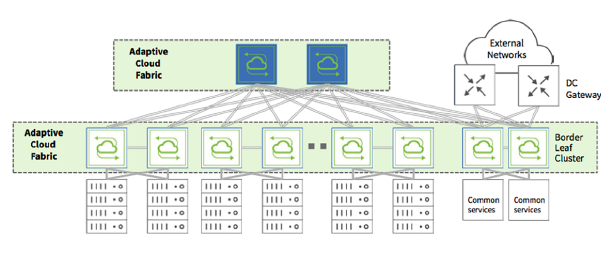
Understanding the Netvisor® ONE Adaptive Cloud Fabric™
Pluribus Networks offers a unique and highly differentiated approach to software-defined networking (SDN), called Adaptive Cloud Fabric. The distributed architecture enables organizations to build scalable private and public clouds that enjoy improved ease of management, reliability, security and performance.
Pluribus Networks’ innovative Netvisor® ONE software virtualizes open networking hardware to build a holistic, standard-based distributed network, referred to as 'a fabric', which provides improved management, automation, telemetry and resiliency.
These enhancements are achieved thanks to the adoption of an advanced network virtualization paradigm.
In a Pluribus fabric every node behaves like a 'virtual module' within a logically-unified physically-distributed 'virtual chassis' which abstracts the network topology1 . Each fabric node shares a common view of the network, including MAC and IP addresses, connections and application flows for management as well as redundancy purposes.
In addition, thanks to advanced embedded telemetry technology, the Netvisor ONE software provides fabric-wide traffic visibility to reveal network congestion issues and application performance bottlenecks so as to speed up troubleshooting, improve operational efficiency and strengthen security.
Pluribus Adaptive Cloud Fabric is a distributed application on top of a standard Layer 2/Layer 3 network that unifies the management plane for all the switches of the fabric (see figure below) and at the same time enhances the network control plane with the ability to automate and simplify several network functions.
Note: 1The Adaptive Cloud Fabric supports any network topology, including ring, leaf-spine and multi-site.

Figure 6 - 1: Adaptive Cloud Fabric Simplified Management with Single IP to Configure and Monitor the Fabric
This distributed control plane is fully symmetrical (or peer-to-peer) so that any node can act as a single point of management for the entire fabric. Therefore, it does not require any controller entity to guarantee the proper operation of the network and hence does not suffer from the intrinsic limits of a centralized control plane SDN architecture (such as split brain problems). At the same time, it is also able to inter-operate with a centralized orchestration system or controller through RESTful APIs or an OVSDB interface. This enables additional powerful management strategies when leveraging popular platforms such as Ansible or OpenDaylight.
Adaptive Cloud Fabric’s advanced transactional model guarantees that device configuration is maintained consistent across fabric nodes and supports also rollback capabilities. Therefore, a single point of provisioning provides 'atomic' fabric-wide configuration with commands that can operate on a list of dispersed fabric devices (instead of simply on individual ones).
Since Adaptive Cloud Fabric does not inherently require special controllers to operate (i.e., uses a controller-less, de-centralized model), and since it leverages standard protocols (instead of proprietary technologies) it is fully interoperable with devices from other vendors.

Figure 6 - 2: Network Orchestration with Adaptive Cloud Fabric
Adaptive Cloud Fabric’s open architecture offers users a far superior degree of interoperability compared to centralized SDN architectures, while at the same time providing support for powerful market-leading network-wide analytics.
While each node can belong to only one fabric, multiple fabric domains can be part of the same network so as to implement more granular management domain segregation.
For example, in a typical leaf and spine data center configuration, it is often preferred to provision one management domain for all leaf switches and one separate domain for all spine switches, so as to preserve homogeneity as well as provisioning and monitoring simplicity within each functional domain.
The following picture (Figure 6-3) depicts an example of data center 'pod' topology comprising two management domains corresponding to two separate fabric instances: one for all the leaf switches and one for the two spine switches.

Figure 6 - 3: Two Fabric Instances to Achieve Two Management Domains
The Adaptive Cloud Fabric technology offers many additional benefits (described in more detail in the following chapters) that include more granular management segmentation for multi-tenancy, geographically dispersed data center interconnection (DCI), sophisticated security, etc.
